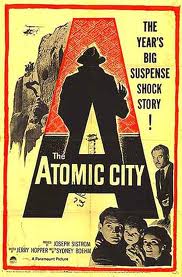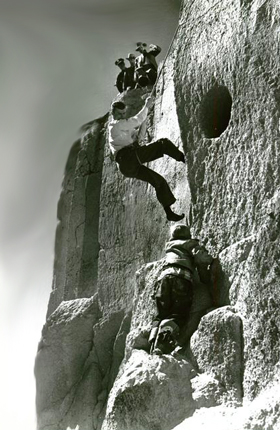
 |
|
|
|
Americans have become more aware lately of the depth and breadth of government spying. The idea of a surveillance state took hold as soon as new technology made systematic wiretapping a practical proposition. The semi-official sanction for this practice was granted after with the revelations of the late 1940s that disloyal Americans had passed atom secrets to the Soviets. The F.B.I. got a green light to investigate any activity it deemed subversive. 1950's McCarran Internal Security Act authorized the emergency detention of subversives. Although it was never really implemented, the military made internal use of the Act. It was cited to harass entertainer-activist Paul Robeson: his passport was revoked, to prevent the singer from spreading his government-critical messages overseas. 1 The climate of fear around the Atom Bomb promoted its development and improvement as an "offensive deterrent". Any scientific or military installation in contact with America's nuclear program was placed under heavy security scrutiny. Made in 1952, Paramount's dead-serious suspense thriller The Atomic City still carries a sinister edge - it is perhaps the only Hollywood picture to openly suggest that America needed to use drastic measures to defend itself against a totalitarian threat. 
The film is not propagandistic, but its story certainly explains the reasoning behind the new atomic security police state. Isolated at a remote and secret mountaintop community, a scientist-engineer working on a top-secret nuclear project lives under intense security scrutiny. When foreign spies kidnap his son to force him to divulge technical secrets, the scientist doesn't know whom to trust. Our intelligence forces are on the job, but their guidelines rank the son's safety as a third level priority -- national security comes first. Writer Sidney Boehm's Oscar nominated screenplay concocts one of the earliest theatrical plotlines involving atomic extortion. First-time director Jerry Hopper pulls it off in admirable style, aided by a capable cast. Physicist Dr. Frank Addison (Gene Barry) works to develop hydrogen bombs at Los Alamos, a security community sometimes called The Atomic City. His wife Martha (Lydia Clarke) thinks Los Alamos is too morbid of an environment in which to raise their young son Tommy (Lee Aaker). When Tommy is snatched on a school outing Frank does his best to keep a level head: the villains demand his entire file on the new bomb research. Frank attempts to handle things on his own by slipping useless formulas to the kidnapper-spies, but the FBI catches on immediately. The doctor accompanies Inspector Mann (Milburn Stone) to Los Angeles to track down the communist cell behind the plot. Left alone with a suspect, Frank beats an address in Santa Fe out of him. The agents race to the scene, only to find the kidnappers' lair abandoned -- except for proof that the spies have uncovered Frank's ruse. Now Tommy will almost certainly be murdered as the conspirators cover their tracks. 
Hollywood did its part in the late forties to push the patriotic Official Story, helping to sell the public on the need for our atomic weapons program. The few films with nuclear themes avoided controversy and minimized the threat of radiation, whether in an attack or from a nuclear accident. MGM's authorized story of the creation of the bomb, The Beginning or the End, is a whitewash truly worthy of the propaganda label. The film noir D.O.A. omitted any mention of radioactivity when a man was murdered via "luminous poisoning". The Atomic City begins with a casualty in a lab accident. It happens off-screen, but the reactions of Frank and Martha underline the high degree of danger involved in nuclear research. More troubling is the screenplay's examination of the security state at Los Alamos, where every scientist is treated as a possible traitor. To fight the totalitarian threat, the Atomic City has resorted to invasive security methods similar to practices in East Germany. Not only do FBI agents accompany Dr. Addison everywhere, undercover men pose as normal friends and neighbors, observing and listening at all times. Martha Addison is troubled by what she thinks is an unhealthy environment, a city that manufactures death. Their son Tommy goes to a good school and enjoys benefits like a new television, but she's alarmed when he says, "If I grow up" instead of "When I grow up." Tommy's no dope -- he can sense that it's a dangerous new world out there. The Atomic City becomes a police procedural when Frank joins the FBI men to track down the spy ring. Suspenseful scenes follow an enemy messenger from a Hollywood hotel to a minor league baseball field in the Fairfax district of Los Angeles. A film of the messenger is shown to a group of ex-communist informants cooperating with the Bureau in Washington. The kidnappers are revealed to be homegrown traitors, communist party members and fellow travelers. America is under siege by espionage agents, and the FBI has its hands full tracking them down. 
The movie assumes that the Soviets will use the bombs if they can make them. The implication is that Americans must adjust themselves to a new post-bomb Cold War environment by abandoning outdated notions of sentiment and legality. Martha is the obvious holdout; when Frank says that the Commies will "wreck half the world" she counters with the plea that Tommy is their whole world. It's a new deal all around. Compared to the dire threat posed by the spies, Tommy's life is of secondary importance. We're all Cold Warriors now. The spies routinely kill their hired functionaries as soon as their usefulness is ended. Frank responds to the Communist brutality by becoming more barbaric himself. When a captured suspect sneers at our democratic laws the physicist storms into his holding cell and beats information out of him. The naked appeal to audience emotion and bloodlust reminds us of scenes in L.A. Confidential or the Home Security hysteria TV show "24". The script gives Frank plenty of knee-jerk motivation to take violent action. This justified-violence theme found its first expression in Hollywood westerns, and has been a standard motivator for American heroes for decades. Sometimes real men just need to take a stand. The script's idea of optimism is its notion that the next generation will not be afraid to go toe-to-toe with America's ideological foes. Frank Addison finds it difficult to adapt, but his son Tommy is a quick learner. The suspenseful finale occurs at an Indian Dwelling in New Mexico, a different kind of city whose inhabitants have also been made "extinct" by territorial competition. We find the boy filthy but unharmed, lulling his captors into a false sense of security with his polite "Yes sir's" and "No sir's". Little Tommy's awareness of the atom threat ("If I grow up") is not weakness but a sign that he knows the score and understands his enemy better than his parents do. He waits for his chance and makes good his escape, using his size to his advantage by scuttling through Native American passageways too narrow for the bad guys. The conclusion is both convincing and uncompromising -- our future may be secure, but only provided that we raise all of our children to be hardboiled Junior G-Men. In other words, The Atomic City's central argument is that liberal pacifism is a form of misguided treason. |
|||||||||||||||||||
Review Staff | About DVD Talk | Newsletter Subscribe | Join DVD Talk Forum
Copyright © MH Sub I, LLC dba Internet Brands. | Privacy Policy
Subscribe to DVDTalk's Newsletters
|